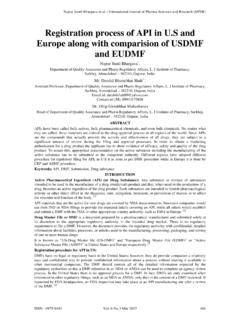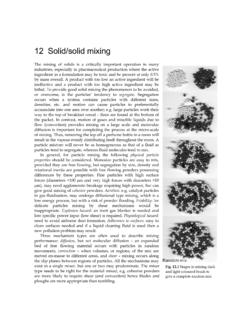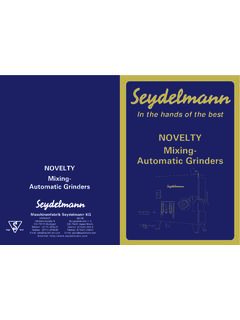Transcription of Enhancement of Solubility of poorly water soluble drug by ...
1 Enhancement of Solubility of poorly water soluble drug by solid dispersion technique *, , , , (1*) , Ishwar Deshmukh institute of pharmacy, Digras- 445203 ABSTRACT: Atovaquone and Satrinidazole has poor Solubility resulting in low oral absorption hence low oral bioavailability. Hence to improve the Solubility of poorly Atovaquone and Satrinidazole , hydrophilic polymers were used to enhance the dissolution by solid dispersion technique. Polyehylene Glycol 4000 and PVP k30 used to enhance the dissolution of both the drug by Solubilisation. Many alternative techniques have been used to improve such bioavailability; this study thus employed the simple solid dispersion technique and incorporated excipients which can increase the bioavailability of these drugs directly enhancing the dissolution rate of the drug and indirectly by reducing particle aim of present work is to enhance the dissolution of poorly water soluble drug by using solid dispersion technique.
2 To improve the dissolution rate, by using the various concentration of carrier or matrix with drug and hence ,improve the bioavailability of poorly water soluble drug by formulating solid enhance the Solubility of poorly water soluble drug ,by means of solubilising agent. In case of poorly water soluble drug , dissolution may be the rate limiting step in the process of absorption. In such case ,we can improve their Solubility and dissolution study the effect of surfactant on the solid dispersion of poorly water soluble drug. Keywords: Solubilisation, solid dispersion, Polyehylene Glycol, bioavailability, dissolution rate etc. INTRODUCTION: Oral bioavailability of drugs depends on its Solubility and/or dissolution rate, therefore major problems associated with these drugs was its very low Solubility in biological fluids, which results into poor bioavailability after oral administration1,3,5.
3 A drug with poor aqueous Solubility will typically exhibit dissolution rate limited absorption, and a drug with poor membrane permeability will typically exhibit permeation rate limited absorption6. Therefore, pharmaceutical researchers, focuses on two areas for improving the oral bioavailability of drugs include: (i) enhancing Solubility and dissolution rate of poorly water - soluble drugs and (ii) enhancing permeability of poorly permeable drugs 7. It has been estimated that 40% of new chemical entities currently being discovered are poorly water soluble8,9. Unfortunately, many of these potential drugs are abandoned in the early stages of development due to the Solubility problems.
4 It is therefore important to realize the Solubility problems of these drugs and methods for overcoming the Solubility limitations are identified and applied commercially so that potential therapeutic benefits of these active solid dispersion (SD) is one of such methods and involves a dispersion of one or more active ingredients in an inert carrier or matrix in solid state prepared by melting, dissolution in solvent or melting-solvent method2,11. The formulation of drugs having low aqueous Solubility using solid dispersion technology has been an active area of research since the various approaches to improve Solubility , the solid dispersion (SD) technique has often proved to be the most successful in improving the dissolution and bioavailability of poorly soluble drugs because it is simple, economic, and advantageous 13.
5 solid dispersion means a group of solid products consisting of at least two different components, generally a hydrophilic inert carrier or matrix and a hydrophobic drug. The carrier can be either crystalline or amorphous in nature. Most commonly used carriers for the preparation of SDs are different grade of polyethylene glycols (PEGs) and polyvinylpyrollidine (PVPs), sugar etc. of solid Dispersion10, 12 of solid dispersions results in particles with reduced particle size and thus the surface area is improved and increased dissolution rate is attained. The ultimate result is improved bioavailability. is improved during solid dispersion production. Improved wettability results in increased Solubility .
6 Here the carriers play the major role to improve the wettability of the particles. in solid dispersions have been found to have a higher degree of porosity. The increased porosity of solid dispersion particles accelerates the drug release profile. Increased porosity also depends on the carrier properties. solid dispersions drugs are presented as supersaturated solutions which are considered to be metastable polymorphic form. Thus presenting drugs in amorphous form increase the Solubility of the particles. et al. / International Journal of Pharma Sciences and Research (IJPSR) ISSN : 0975-9492 Vol. 6 Feb dissolution rates that result in an increase in the rate and extent of the absorption of the drug, and a reduction in presystemic both can lead to the need for lower doses of the drug.
7 Disadvantages of solid Dispersion12 The major disadvantages of solid dispersion are related to their instability. Several systems have shown changes in crystalline and a decrease in dissolution rate with aging. The crystallization of Ritonavir from the supersaturated solution in a soliddispersion system was responsible for the withdrawal of the Ritonavir capsule (Norvir, Abboft) from the market. Moisture and temperature have more of a deterioratingeffect on solid dispersions than on physical mixtures. Some solid dispersion may not lend them to easy handling because of tackiness LIMITATIONS OF solid DISPERSIONS3 Although a great research interest in solid dispersion in the past four decades, the commercial utilization is very limited.
8 Problems of solid dispersion involve 1) The physical and chemical stability of drugs and vehicles, 2) Method of preparation, Reproducibility of its physicochemical properties 3) Formulation of solid dispersion into dosage forms, and 4) Scale-up of manufacturing processes17. Classification of solid dispersion, On the basis of carrier used First generation First generation solid dispersions were prepared using crystalline carriers such as urea and sugar,which were the first carriers to be employed in solid dispersion. They have the disadvantage of forming crystalline solid dispersion, which were thermodynamically more stable and did not release the drug as quickly as amorphous ones.
9 Second generation Second generation solid dispersions include amorphous carriers instead of crystalline carriers which are usually polymers. These polymers include synthetic polymers such as povidone (PVP), polyethyleneglycols (PEG) and polymethacrylates as well as natural product based polymers such as hydroxylpropylmethyl-cellulose (HPMC), ethyl cellulose, and hydroxypropoylcellulose or starch derivates like cyclodextrins. Third generation Recently, it has been shown that the dissolution profile can be improved if the carrier has surface activity or self emulsifying properties. Therefore, third generation solid dispersions appeared. The use of surfactant such as inulin, inutec SP1, compritol 888 ATO, and poloxamer 407 as carriers was shown to be effective in originating high polymorphic purity and enhanced in vivo bioavailability6.
10 On the basis of solid state Drug and polymer exhibiting immiscibility in fluid state If a drug and polymer are immiscible in their fluid state, it is expected that they would not exhibit miscibility on solidification of the fluid mixture. Such systems may be regarded as similar to their corresponding physical mixtures and any Enhancement in dissolution performance may be owing to modification in morphology of drug and/or polymer due to physical transformation ( , solid to liquid state and back), intimate drug polymer mixing, and/or enhanced surface of crystalline or amorphous soliddispersions can be biased by the rate of solidification of mixture and the rate of crystallization of drug and/or polymer 9.












